Bartending is a blend of creativity, precision, and showmanship, transforming spirits, juices, and mixers into memorable experiences. Mastering the craft requires understanding ingredients, techniques, and presentation.
Understanding the Basics of Mixology
Understanding the basics of mixology involves mastering core principles like flavor balancing, ingredient combinations, and techniques. Mixology is the art and science of crafting cocktails, emphasizing harmony between sweet, sour, bitter, and umami flavors. Spirits form the foundation, with liqueurs, juices, and mixers enhancing the profile. A deep understanding of flavor profiles allows bartenders to create balanced and appealing drinks. Essential techniques include shaking, stirring, and straining, which affect texture and dilution. Mixology also explores the role of ice, dilution, and garnishes in transforming raw ingredients into refined cocktails. This foundation is crucial for both classic and innovative drink creation, ensuring quality and consistency.
Essential Tools Every Bartender Needs
A well-equipped bartender relies on key tools to craft precise and visually appealing cocktails. A Boston shaker is indispensable for mixing and chilling ingredients, while a jigger ensures accurate measurements. A muddler is used to gently press fruits and herbs, releasing their flavors without bruising. Bar spoons are ideal for stirring and layering drinks, and a Hawthorne strainer helps strain cocktails smoothly. Ice tongs and a citrus juicer are also crucial for handling ice and extracting fresh juices. These tools not only enhance efficiency but also elevate the quality and presentation of cocktails, making them essential for every professional and aspiring bartender.
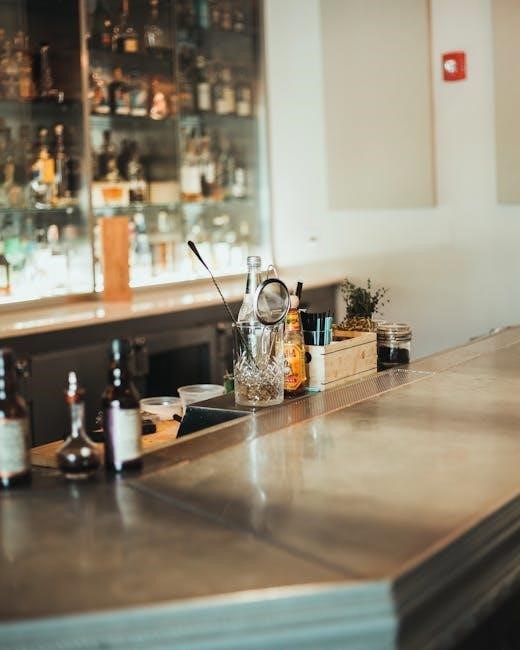
Key Cocktail Ingredients
Cocktails rely on essential ingredients like spirits, liqueurs, fresh juices, syrups, mixers, and bitters, each playing a crucial role in balancing flavors and creating diverse profiles.
Common Spirits and Liqueurs
Common spirits include gin, vodka, rum, tequila, and whiskey, each offering distinct flavors. Liqueurs, such as triple sec, Campari, and vermouth, add depth and complexity. These ingredients are foundational in mixology, allowing bartenders to craft classic and modern recipes. Spirits form the base, while liqueurs enhance the profile, balancing sweetness and bitterness. Understanding their roles is key to creating well-rounded cocktails that appeal to diverse palates. Mastery of these components is essential for every bartender aiming to deliver exceptional drinks.
Important Juices, Syrups, and Mixers
Juices, syrups, and mixers are vital for adding flavor, texture, and balance to cocktails. Common juices include lemon, lime, orange, grapefruit, and cranberry, often used for acidity and freshness. Syrups, like simple syrup or agave, sweeten drinks without dissolving issues. Grenadine, a sweet-tart syrup, is popular in classics like the Tequila Sunrise. Mixers such as tonic water, soda, or ginger beer enhance flavors and carbonation. These ingredients allow bartenders to craft versatile, layered beverages, ensuring a harmonious blend of sweet, sour, and bitter notes. Mastery of these elements is essential for creating memorable and balanced cocktails.
Core Cocktail Techniques
Mastering core techniques like shaking, stirring, and straining ensures balanced, visually appealing cocktails. Proper dilution and ice handling are crucial for achieving the perfect flavor and texture.
Shaking, Stirring, and Straining
Shaking combines ingredients with ice, creating a refreshing, diluted texture, while stirring maintains clarity and flavor in drinks like martinis. Straining ensures ice stays out, preserving the drink’s integrity and presentation.
Measuring and Pouring Accurately
Precise measurements are crucial for balanced cocktails. Jiggers and measuring cups ensure accurate pours, while techniques like free-pouring, once mastered, offer efficiency. Consistency in every pour guarantees perfect flavors every time.
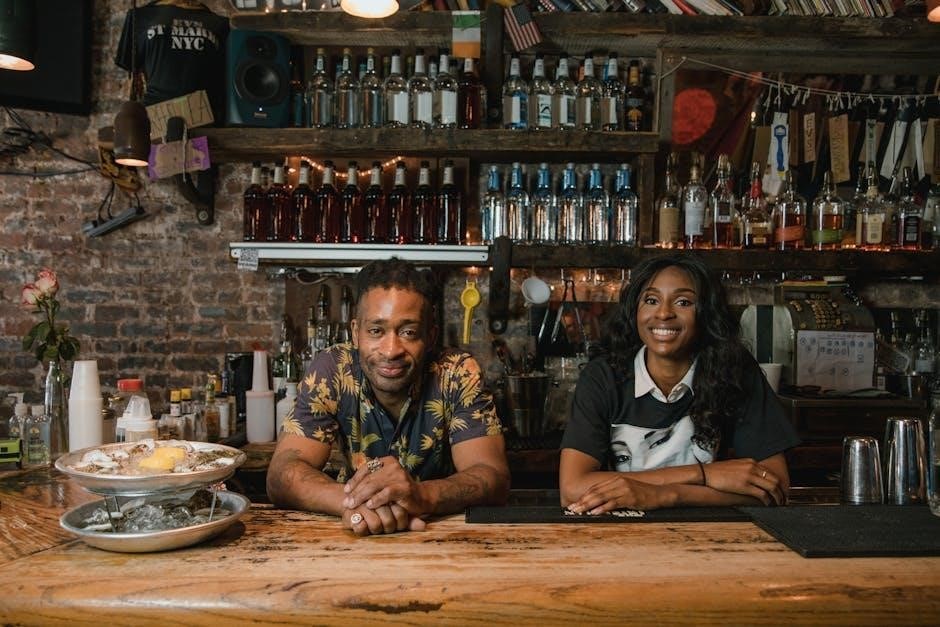
Classic Cocktails Every Bartender Should Know
Mastering timeless classics like the Old Fashioned, Negroni, and Gin Martini is essential. These cocktails showcase balanced flavors and techniques, forming the foundation of a bartender’s repertoire.
Old Fashioned, Negroni, and Gin Martini
The Old Fashioned, a timeless classic, combines bourbon or rye whiskey with bitters and sugar, served over ice with an orange peel. The Negroni, an Italian staple, blends gin, Campari, and sweet vermouth, offering a bold, bitter taste. The Gin Martini, a sophisticated favorite, pairs gin with dry vermouth, garnished with an olive or lemon twist. These cocktails exemplify simplicity and balance, relying on quality ingredients and precise measurements. They are must-know recipes for any bartender, symbolizing the art of mixology and its enduring appeal to cocktail enthusiasts worldwide.
Daiquiri, Margarita, and Other Timeless Recipes
The Daiquiri, a tropical classic, mixes rum, lime juice, and simple syrup, served chilled with a crisp lime wedge. The Margarita, a vibrant favorite, combines tequila, lime juice, and triple sec, often rimmed with salt for added flair. These cocktails, along with others like the Mojito and Mai Tai, showcase diverse flavors and techniques. They are essential for bartenders, offering simplicity and versatility. Mastering these recipes allows for creative variations while maintaining the integrity of their original charm, making them staples in any cocktail menu and crowd-pleasers for generations of drinkers.
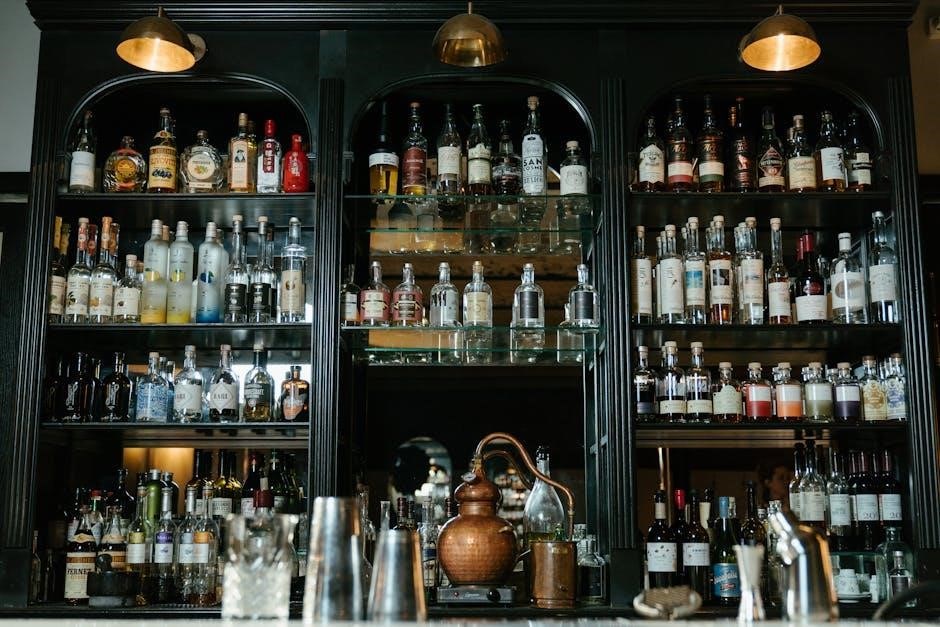
Bartender Dos and Don’ts
Master small talk to engage customers, but avoid over-sharing. Stay efficient behind the bar to manage orders smoothly, ensuring a seamless and enjoyable experience for everyone.
Mastering Small Talk and Customer Interaction
Engaging with customers is key to a bartender’s success. Start with friendly icebreakers like asking about their day or preferences. Listen actively and adapt conversations to their interests. Be knowledgeable about your menu to guide choices and build trust. Small talk is about balancing attentiveness without being intrusive. Use humor wisely to create a welcoming atmosphere. Remembering regulars’ favorite drinks or preferences shows dedication and enhances loyalty. Conversely, avoid controversial topics or over-sharing personal details. Stay professional, approachable, and attentive to ensure every interaction leaves a positive impression. This skill not only boosts tips but also fosters a loyal clientele.
Efficiency Behind the Bar: Tips and Tricks
Efficiency is crucial for a seamless bartending experience. Organize your workspace by stationing tools and ingredients within easy reach. Pre-batch common mixers and prep garnishes during slow periods. Use a jigger for precise measurements to minimize waste. Multitask by rinsing glasses while shaking cocktails. Prioritize orders, starting with simple serves. Keep a clean workspace to avoid clutter and distractions. Maintain a well-stocked bar with essentials like ice and napkins. Timing is key—balance drink preparation with customer interaction. Stay alert and anticipate demands, especially during peak hours. These habits ensure smooth service, enhancing both efficiency and customer satisfaction.
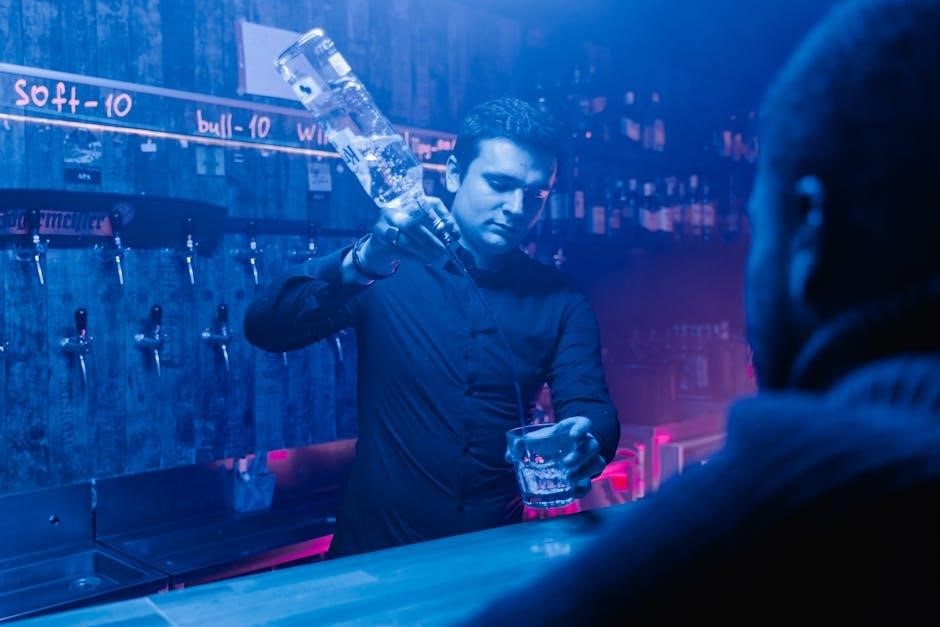
Advanced Cocktail Techniques
Explore molecular mixology with techniques like spherification and foamification. Incorporate craft ingredients to create visually stunning and innovative cocktails that push the boundaries of flavor and presentation.
Molecular Mixology and Craft Ingredients
Molecular mixology introduces scientific techniques like spherification, gelification, and foamification, transforming cocktails into visually stunning creations. Craft ingredients, such as house-made infusions, fresh juices, and rare spirits, add depth and originality. Tools like centrifuges and smokers enhance flavor profiles, enabling bartenders to innovate and create distinctive drinks that wow patrons. This advanced approach pushes creativity, blending art and science to craft memorable cocktail experiences.
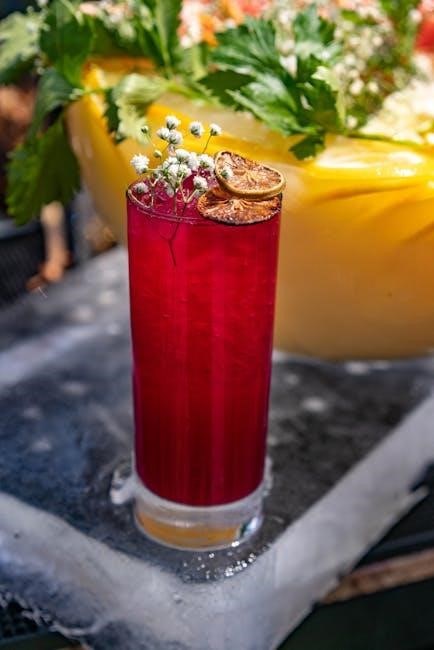
Understanding Drink Specifications
Drink specifications ensure consistency and quality, detailing exact measurements, techniques, and presentation. Glassware selection and garnishes enhance the experience, making every drink visually appealing and flavorful.
The Importance of Glassware and Garnishes
Proper glassware elevates the cocktail experience, as different shapes enhance aroma and flavor. A highball glass suits tall drinks, while a coupe glass is ideal for sipping cocktails. Garnishes like citrus twists, olives, or mint add visual appeal and refine the drink’s aroma, making them essential for a polished presentation. They also serve as a finishing touch, balancing flavors and creating a sensory experience. Selecting the right glass and garnish ensures the cocktail is enjoyed as intended, highlighting the bartender’s attention to detail and craftsmanship.
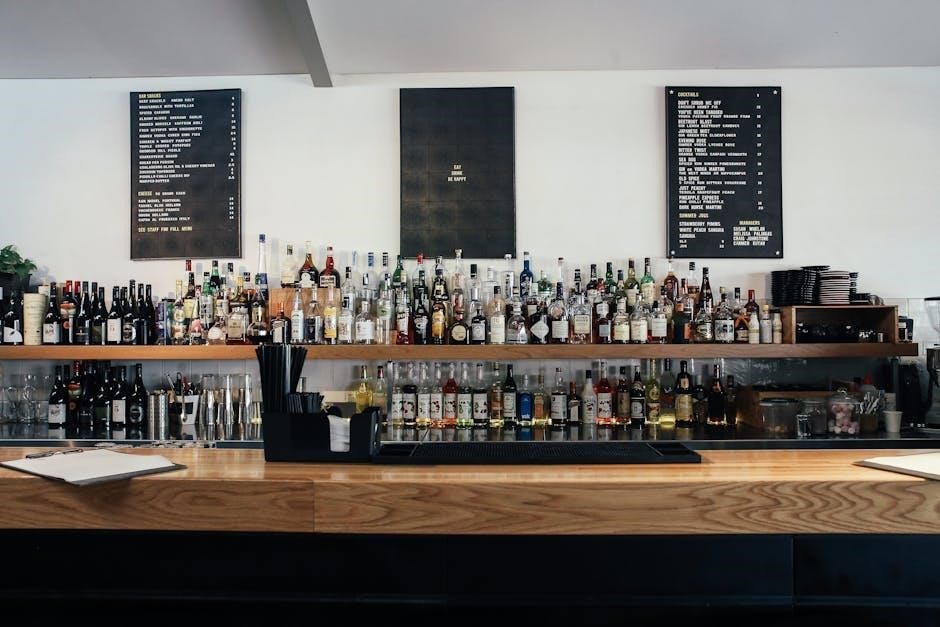
Resources for Bartenders
Explore essential bartending resources, including online guides, workshops, and communities, to refine skills and stay updated on trends and techniques in mixology.
Recommended Books and Online Guides
Enhance your bartending journey with “The Bartender’s Bible,” a comprehensive guide covering classic recipes and techniques. Online platforms like Imbibe Magazine and The Spruce Eats offer tutorials, recipes, and expert advice. These resources provide insights into mixology trends, ingredient pairings, and advanced methods, helping you refine your craft. Whether you’re a novice or an experienced bartender, these books and guides are invaluable for mastering cocktail creation and staying updated on industry standards. They also feature tips on efficiency, customer interaction, and presentation, ensuring a well-rounded skill set behind the bar.
